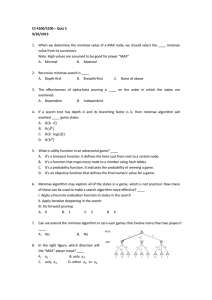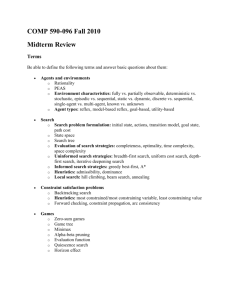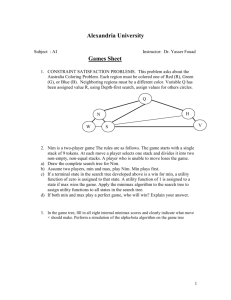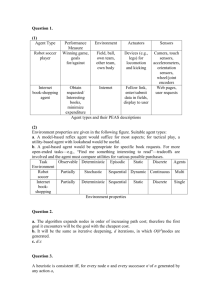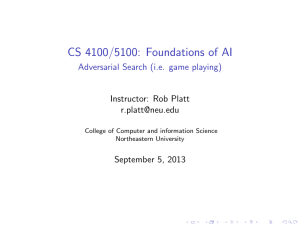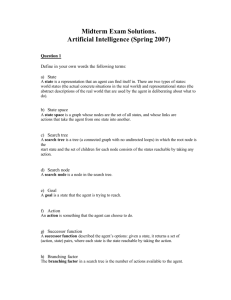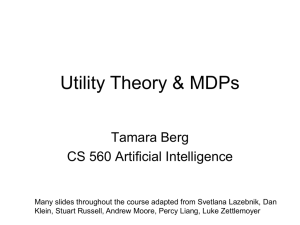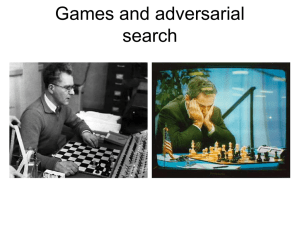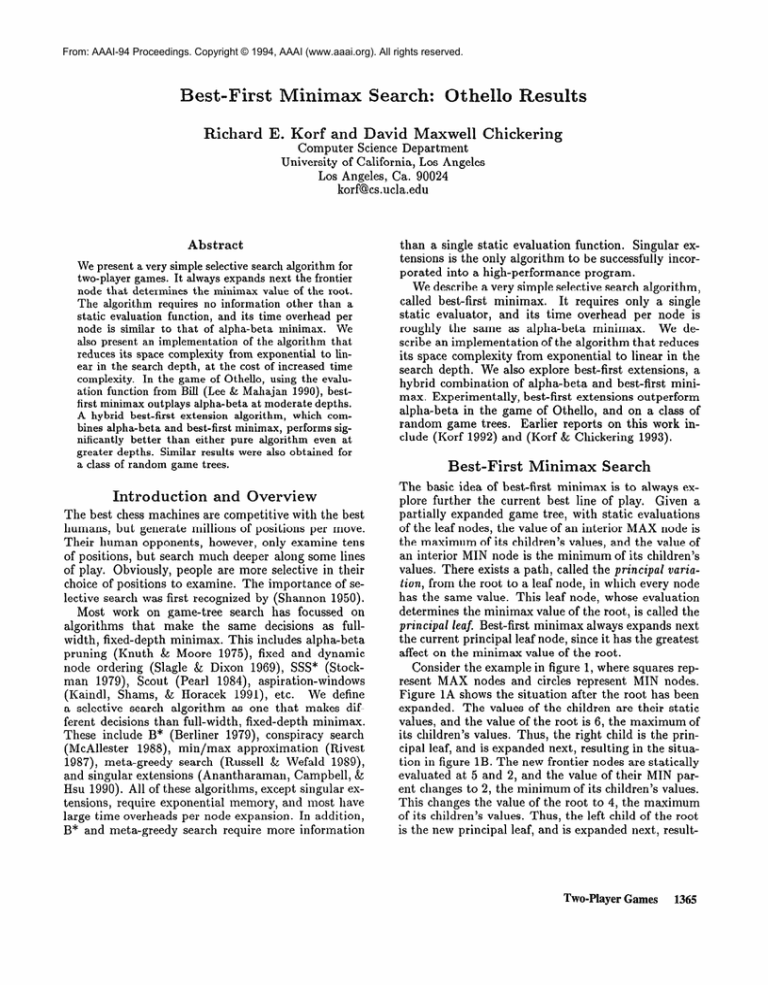
From: AAAI-94 Proceedings. Copyright © 1994, AAAI (www.aaai.org). All rights reserved.
Best-First
Richard
Minimax
E. Korf and David
We present a very simple selective search algorithm for
two-player games. It always expands next the frontier
node that determines the minimax value of the root.
The algorithm requires no information other than a
static evaluation function, and its time overhead per
node is similar to that of alpha-beta minimax. We
also present an implementation of the algorithm that
reduces its space complexity from exponential to linear in the search depth, at the cost of increased time
complexity. In the game of Othello, using the evaluation function from BiIl (Lee & Mahajan 1990), bestfirst minimax outplays alpha-beta at moderate depths.
A hybrid best-first
extension
algorithm,
which combines alpha-beta
and best-first minimax, performs significantly
better than either pure algorithm
even at
greater depths.
Similar results were also obtained for
a class of random game trees.
and Overview
The best chess machines are competitive with the best
humans, but generate millions of positions per move.
Their human opponents, however, only examine tens
of positions, but search much deeper along some lines
of play. Obviously, people are more selective in their
choice of positions to examine. The importance of selective search was first recognized by (Shannon 1950).
Most work on game-tree search has focussed on
algorithms that make the same decisions as fullwidth, fixed-depth minimax. This includes alpha-beta
pruning (Knuth & Moore 1975), fixed and dynamic
node ordering (Slagle & Dixon 1969), SSS* (Stockman 1979), Scout (Pearl 1984), aspiration-windows
(Kaindl, Shams, & Horacek 1991), etc. We define
a selective search algorithm as one that makes different
decisions
than
full-width,
Maxwell
Computer Science Department
University of California, Los Angeles
Los Angeles, Ca. 90024
korf@cs.ucla.edu
Abstract
Introduction
Search: Othello Results
fixed-depth
minimax.
These include B* (Berliner 1979), conspiracy search
(McAllester 1988), min/max approximation (Rivest
1987), meta-greedy search (Russell & Wefald 1989),
and singular extensions (Anantharaman, Campbell, &
Hsu 1990). All of these algorithms, except singular extensions, require exponential memory, and most have
large time overheads per node expansion. In addition,
B* and meta-greedy search require more information
Chickering
than a single static evaluation function. Singular extensions is the only algorithm to be successfully incorporated into a high-performance program.
We describe a very simple selective search algorithm,
called best-first minimax.
It requires only a single
static evaluator, and its time overhead per node is
roughly the same as alpha-beta minimax.
We describe an implementation of the algorithm that reduces
its space complexity from exponential to linear in the
search depth. We also explore best-first extensions, a
hybrid combination of alpha-beta and best-first minimax. Experimentally, best-first extensions outperform
alpha-beta in the game of Othello, and on a class of
random game trees. Earlier reports on this work include (Korf 1992) and (Korf & Chickering 1993).
Best-First
Minimax
Search
The basic idea of best-first minimax is to always explore further the current best line of play. Given a
partially expanded game tree, with static evaluations
of the leaf nodes, the value of an interior MAX node is
the maximum of its children’s values, and the value of
an interior MIN node is the minimum of its children’s
values. There exists a path, called the principal variation, from the root to a leaf node, in which every node
has the same value. This leaf node, whose evaluation
determines the mini max value of the root, is called the
principal leaf. Best-first minimax always expands next
the current principal leaf node, since it has the greatest
affect on the minimax value of the root.
Consider the example in figure 1, where squares represent MAX nodes and circles represent MIN nodes.
Figure 1A shows the situation after the root has been
expanded. The values of the children are their static
values, and the value of the root is 6, the maximum of
its children’s values. Thus, the right child is the principal leaf, and is expanded next, resulting in the situation in figure 1B. The new frontier nodes are statically
evaluated at 5 and 2, and the value of their MIN parent changes to 2, the minimum of its children’s values.
This changes the value of the root to 4, the maximum
of its children’s values. Thus, the left child of the root
is the new principal leaf, and is expanded next, result-
Two-Player Games
1365
w
A
6
4
6
Figure 1: Best-first minimax search example
ing in the situation in figure 1C. The value of the left
child of the root changes to the minimum of its children’s values, 1, and the value of the root changes to
the maximum of its children’s values, 2. At this point,
the rightmost grandchild is the new principal leaf, and
is expanded next, as shown in figure 1D.
By always expanding the principal leaf, best-first
minimax may appear to suffer from the exploration of
a single path to the exclusion of all others. This does
not occur in practice, however. The reason is that the
expansion of a node tends to make it look worse, thus
inhibiting further exploration of the subtree below it.
For example, a MAX node will only be expanded if
its static value is the minimum among its brothers,
since its parent is a MIN node. Expanding it changes
its value to the maximum of its children, which tends
to increase its value, making it less likely to remain as
the minimum among its siblings. Similarly, hlIN nodes
also tend to appear worse to their MAX parents when
expanded, making it less likely that their children will
be expanded next. This tempo effect adds balance to
the tree searched by best-first minimax, and increases
with increasing branching factor. Surprisingly, while
this oscillation in values with the last player to move
is the reason that alpha-beta avoids comparing nodes
at different levels in the tree, it turns out to be advantageous to best-first minimax.
While in principle best-first minimax could make a
move at any point in time, we choose to move when
the length of the principal variation exceeds a given
depth bound, or a winning terminal node is chosen for
expansion. This ensures that the chosen move has been
explored to a significant depth, or leads to a win.
The simplest implementation of best-first minimax
maintains the current tree in memory. When a node
is expanded, its children are evaluated, its value is updated, and the algorithm moves up the tree updating
the values of its ancestors, until it reaches the root,
or a node whose value doesn’t change. It then moves
down the tree to a maximum-valued child of a MAX
node, or a minimum-valued child of a MIN node, until
1366
Search
it reaches a new principal leaf. A drawback of this implementation is that it requires exponential memory, a
problem that we address below.
Despite its simplicity, best-first minimax has apparently not been explored before. The algorithm is mentioned as a special case of AO*, a best-first search of an
AND-OR tree, in (Nilsson 1969). The chess algorithm
of (Kozdrowicki & Cooper 1973) seems related, but
behaves differently on their examples. Best-first minimax is also related to conspiracy search (McAllester
19SS), and only expands nodes in the conspiracy set.
It is also related to Rivest’s min/max approximation
(Rivest 1987). Both algorithms strive to expand next
the node with the largest affect on the root value, but
best-first minimax is much simpler. All four related
algorithms above require exponential memory.
Recursive
Best-First
Minimax
Search
Recursive Best-First Minimax Search (RBFMS) is an
implementation of best-first minimax that runs in
space linear in the search depth. The algorithm is a
generalization of Simple Recursive Best-First Search
(SRBFS) (Korf, 1993), a linear-space best-first search
designed for single-agent problems. Figure 2 shows the
behavior of RBFMS on the example of figure 1.
Associated with each node on the principal variation
is a lower bound Alpha, and an upper bound Beta,
similar to the bounds in alpha-beta pruning. A node
will remain on the principal variation as long as its
minimax value stays within these bounds. The root is
bounded by -oo and 00. Figure 2A shows the situation after the root is expanded, with the right child on
the principal variation. It will remain on the principal
variation as long as its minimax value is greater than
or equal to the maximum value of its siblings (4). The
right child is expanded next, as shown in figure 2B.
The value of the right child changes to the minimum
of its children’s values (5 and 2), and since 2 is less than
the lower bound of 4, the right child is no longer on
the principal variation, and the left child of the root is
the new principal leaf. The algorithm returns to the
Figure 2: Recursive best-first minimax search example
root, freeing memory, but stores with the right child its
new minimax value of 2, as shown in figure 2C. This
method of backing up values and freeing memory is
similar to that of (Chakrabarti et al. 1989).
The left child of the root will remain on the principal
variation as long as its value is greater than or equal to
2, the largest value among its siblings. It is expanded,
as shown in figure 2D. Its new value is the minimum
of its children’s values (8 and 1)) and since 1 is less
than the lower bound of 2, the left child is no longer
on the principal variation, and the right child of the
root becomes the new principal leaf. The algorithm
returns to the root, and stores the new minimax value
of 1 with the left child, as shown in figure 2E. Now,
the right child of the root will remain on the principal
variation as long as its minimax value is greater than
or equal to 1, the value of its best sibling, and is expanded next. The reader is encouraged to complete the
example. Note that the values of interior nodes on the
principal variation are not computed until necessary.
RBFMS consists of two recursive and entirely symmetric functions, one for MAX and one for MIN. Each
takes three arguments: a node, a lower bound Alpha,
and an upper bound Beta. Together they perform
a best-first minimax search of the subtree below the
node, as long as its backed-up minimax value remains
within the Alpha and Beta bounds. Once it exceeds
those bounds, the function returns the new backed-up
minimax value of the node. At any point, the recursion
stack contains the current principal variation, plus the
siblings of all nodes on this path. Its space complexity
is thus O(bd), where b is the branching factor of the
tree, and d is the maximum depth.
The children of a node are generated and evaluated
one at a time. If the value of any child of a MAX node
exceeds Beta, or the value of any child of a MIN node
is less than Alpha, that child’s value is immediately
returned, without generating the remaining children.
BFMAX (Node, Alpha, Beta)
FOR each Child[i] of Node
M cil := Evaluation(Child[i])
IF M[i] > Beta return M[i]
SORT ChildCi] and Mb] in decreasing order
IF only one child, MC21 := -infinity
WHILE Alpha <= ML11 C= Beta
MC11 := BFMIN(Child~l],max(Alpha,MC21),Beta)
insert ChildCll and MC11 in sorted order
return M Cl]
BFMIN (Node, Alpha, Beta)
FOR each Child[i] of Node
MCil := Evaluation(Child[il)
IF M[i] < Alpha return M[i]
SORT Child[il and Mb] in increasing order
IF only one child, MC21 := infinity
WHILE Alpha <= MC13 <= Beta
MC11 := BFMAX(Child[ll,Alpha,min(Beta,M[2]))
insert Child[l] and MC11 in sorted order
return M Cl1
Two-Player Games
1367
Syntactically, recursive best-first minimax appears
very similar to alpha-beta, but behaves quite differently. Alpha-beta makes its move decisions based on
the values of nodes all at the same depth, while bestfirst minimax relies on node values at different levels.’
Saving the Tree
RBFMS reduces the space complexity of best-first minimax by generating some nodes more than once. This
overhead is significant for deep searches. On the other
hand, the time per node generation for RBFMS is less
than for standard best-first minimax. In the standard
implementation, when a new node is generated, the
state of its parent is copied, along with any changes to
it. The recursive algorithm does not copy the state,
but rather makes only incremental changes to a single
copy, and undoes them when backtracking.
Our actual implementation uses the recursive control
structure of RBFMS. When backing up the tree, however, the subtree is retained in memory. Thus, when a
path is abandoned and then reexplored, the entire subtree is not regenerated, While this requires exponential
space, it is not a major problem, for several reasons.
The first is that once a move is made, and the opponent moves, we only save the remaining relevant subtree, and prune the subtrees below moves that weren’t
chosen by either player, releasing the corresponding
memory. While current machines will exhaust their
memories in minutes, in a two-player game, moves are
made every few minutes, freeing much of the memory.
The second reason that memory is not a serious constraint is that only the backed-up minimax value of a
node, and pointers to its children must be saved. The
actual game state, and alpha and beta bounds, are incrementally generated from the parent. Thus, a node
only requires a few words of memory.
If memory is exhausted while computing a move,
however, there are two options. One is to complete the
current move search using the linear-space algorithm,
thus requiring no more memory than for the recursion stack. The other is to prune the least promising
parts of the current search tree. Since all nodes off the
principal variation have their backed-up minimax values stored at all times, pruning is simply a matter of
recursively freeing the memory in a given subtree.
Since best-first minimax spends most of its time on
the expected line of play, it can save much of the tree
computed for one move, and apply it to subsequent
moves, particularly if the opponent moves as expected.
Saving the tree between moves improves the performance considerably. In contrast, the standard depthfirst implementation of alpha-beta doesn’t save the tree
from one move to the next, but only a subset of the
‘While Recursive Best-First Search (RBFS) is more efficient than Simple Recursive Best-First Search (SRBFS)
for single-agent problems (Korf 1993), the minimax generalizations of these two algorithms behave identically.-
1368
Search
nodes in a transposition table. Even if alpha-beta is
modified to save the tree, since it searches every move
to the same depth, relatively little of the subtree computed during one move is still relevant after the player’s
and opponent’s moves. In the best case, when alphabeta searches the minimal tree and the opponent moves
as expected, only l/b of the tree that is generated in
computing one move is still relevant after the player’s
and opponent’s moves, where b is the branching factor.
Othello
Results
The test of a selective search algorithm is how well
it plays. We played best-first minimax against alphabeta in the game of Othello, giving both algorithms the
same amount of computation, and the same evaluation
function from the program Bill (Lee & Mahajan 1990),
one of the world’s best Othello players.
The efficiency of alpha-beta is greatly affected by
the order in which nodes are searched. The simplest
ordering scheme, called fixed ordering (Slagle & Dixon
1969), fully expands each node, statically evaluates
each child, sorts the children by their values, and then
searches the children of MAX nodes in decreasing order, and the children of MIN nodes in increasing order.
We use fixed ordering on newly generated nodes until
one level above the search horizon. At that point, since
there is no advantage to further ordering, the children
are evaluated one at a time, allowing additional pruning. To ensure a fair comparison to best-first minimax,
our alpha-beta implementation saves the relevant subtree from one move to the next. This allows us to order
previously generated nodes by their backed-up values
rather than their static values, further improving the
node ordering and performance of alpha-beta.
Each tournament consisted of 244 pairs of games.
Different games were generated by making all possible first four moves, and starting the game with the
fifth move. Each game was played twice, with each
algorithm moving first, to eliminate the effect of a particular initial state favoring the first or second player
to move. An Othello game is won by the player with
the most discs at the end. About 3% of the games were
tied, and are ignored in the results presented below.
When alpha-beta can search to the end of the game,
both algorithms use alpha-beta to complete the game,
since alpha-beta is optimal when the static values are
exact. In Othello, the disc differential is the exact
value at the end of the game. Since best-first minimax
searches deeper than alpha-beta in the same amount
of time, however, it reaches the endgame before alphabeta does. Since disc differentials are not comparable to the values returned by Bill’s heuristic function,
best-first minimax evaluates endgame positions at -oo
if MAX has lost, 00 if MAX has won, and -oo + 1 for
ties. If the principal leaf is a winning terminal node
for best-first, it stops searching and makes a move. If
alpha-beta makes the expected response, the principal
leaf doesn’t change, and best-first minimax will make
AB depth
BF depth
BF wins
1
2
1
St%
SO%
3
7%
4
i:%
S
15
57%
6
19
68%
7
23
Sl%
Table 1: Pure best-first vs. alpha-beta on Othello
its next move without further search. Conversely, if
the principal leaf is a loss or tie, best-first minimax
will continue to search until it finds a win, or runs out
of time. While this endgame play is not ideal, it is the
most natural extension of best-first minimax.
For each alpha-beta search horizon, we experimentally determined what depth limit caused best-first
minimax to take most nearly the same amount of time.
This was done by running a series of tournaments, and
incrementing the search horizon of the algorithm that
took less time in the last tournament. Node evaluation is the dominant cost, and running time is roughly
proportional to the number of node evaluations.
Table 1 shows the results of these experiments. The
top line shows the alpha-beta search depths, and the
second line shows the best-first search depth that took
most nearly the same amount of time as the corresponding alpha-beta depth. The third line shows the
percentage of games that were won by best-first minimax, excluding ties. Each data point is an average of
244 pairs of games, or 488 total games.
Both algorithms are identical at depth one.
At
greater depths, best-first searches deeper than alphabeta, and wins most of the time. Its winning percentage increases to 78%, but then begins to drop off as
the gap between the alpha-beta and best-first horizons
becomes very large. At greater depths, we believe that
best-first will lose to alpha-beta.
Best-First
Extensions
One explanation for this performance degradation is
that while best-first minimax evaluates every child of
the root, it may not generate some grandchildren, depending on the static values of the children. In particular, if the evaluation function grossly underestimates
the value of a node, it may never be expanded. For
example, this might occur in a piece trade that begins
with a sacrifice. At some point, it makes more sense
to consider all grandchildren of the root, rather than
nodes 23 moves down the principal variation.
To correct this, we implemented a hybrid algorithm,
called best-first extension, that combines the uniform
coverage of alpha-beta with the penetration of bestfirst minimax.
Best-first extension performs alphabeta to a shallow search horizon, and then executes
best-first minimax to a greater depth, starting with the
tree, backed-up values, and principal variation generated by the alpha-beta search. This guarantees that
every move will be explored to a minimum depth, regardless of its evaluation, before exploring the most
promising moves much deeper. This is similar to the
AB depth 1
2
BF depth 1
4
BF wins SO% 67%
3
7
83%
4
10
81%
S
14
67%
6
18
72%
Table 2: Best-first extension vs. alphsbeta
7
21
67%
8
24
60%
on Othello
idea of principal variation lookahead extensions (Anantharaman 1990).
Best-first extension has two parameters: the depth
of the initial alpha-beta search, and the depth of the
subsequent best-first search. In our experiments, the
alpha-beta horizon of the initial search was set to one
less than the horizon of its pure alpha-beta opponent,
and the best-first horizon was whatever depth took
most nearly the same total amount of time, including the initial alpha-beta search, as the pure alphabeta opponent. Even in this case, most of the time is
spent on the best-first extension. Table 2 shows the
results for Othello, in the same format as table 1. At
alpha-beta depths greater than two, best-first extension performs significantly better than both alpha-beta
and pure best-first minimax. At increasing depths the
results appear to stabilize, with best-first extension defeating alpha-beta about two out of three games.
Random
Game
Tree Results
As a separate test of our results, we also experimented
with a class of random game trees (Fuller, Gaschnig,
& Gillogly 1973). In a uniform random game tree with
branching factor 6 and depth d, each edge is independently assigned a random cost. The static heuristic
evaluation of a node is the sum of the edge costs from
the root to the node. Since real games do not have uniform branching factors, we let the number of children
of any node be a random variable uniformly distributed
from one to a maximum branching factor B. In order
not to favor MAX or MIN, the edge-cost distribution
is symmetric around zero. Our edge-cost distribution
was uniform from -215 to 215.
Different random games were generated from different random seeds. Each game was played twice,
with each algorithm moving first. A random game
ends when a terminal position is reached, 100 moves
in our experiments, and returns the static value of the
final position as the outcome. Given a pair of random
games, and the corresponding terminal values reached,
the winner is the algorithm that played MAX when the
larger terminal value was obtained. Each random game
tournament consisted of 100 pairs of games.
In random games with maximum branching factors
ranging from 2 to 20, we obtained results similar to
those for Othello (Korf & Chickering 1993). In particular, pure best-first outplayed alpha beta at shallow depths, but tended to lose at greater depths, while
best-first extension outplayed alpha-beta at all depths.
Two-Player Games
1369
Conclusions
and Further Work
We presented a very simple selective search algorithm,
best-first minimax. It always expands next the frontier node at the end of the current principal variation,
which is the node that determines the minimax value
of the root. One advantage of the algorithm is that
it can save most of the results from one move computation, and apply them to subsequent moves. In
experiments on Othello, best-first minimax outplays
alpha-beta, giving both algorithms the same amount
of computation and evaluation function, up to a given
search depth, but starts to lose beyond that depth.
We also presented a hybrid combination of best-first
minimax and alpha-beta, which guarantees that every move is searched to a minimum depth. This bestfirst extension outperforms both algorithms, defeating
alpha-beta roughly two out of three games. While
memory was not a limiting factor in our experiments,
we also showed how to reduce the space complexity of
the algorithm from exponential to linear in the search
depth, but at significant cost in nodes generated for
deep searches. Finally, we performed the same experiments on a class of random games, with similar results.
Since pure best-first minimax performs best against
relatively shallow alpha-beta searches, it is likely to
be most valuable in games with large branching factors, and/or expensive evaluation functions.
These
are games, such as Go, in which computers have been
least successful against humans. Current research is
focussed on implementing singular extensions in an attempt to improve our alpha-beta opponent, and implementations on other games.
Acknowledgements
Thanks to Kai-Fu Lee for the sources to Bill, to Judea
Pearl, Joe Pemberton, and Weixiong Zhang for many
helpful discussions, and to Hermann Kaindl for comments on an earlier draft. This work was supported by
NSF Grant No. IRI-9119825, and a grant from Rockwell International.
References
Anantharaman, T.S., A statistical study of selective
min-max search in computer chess, Ph.D. Thesis,
Dept. of Computer Science, Carnegie-Mellon Univ.,
Pittsburgh, Pa. 1990.
Anantharaman, T., M.S. Campbell, and F.-H. Hsu,
Singular extensions: Adding selectivity to brute-force
searching, Artificial Intelligence, Vol. 43, No. 1, 1990,
pp. 99-109.
Berliner, H.J., The B* tree search algorithm: A bestfirst proof procedure, Artificial Inteldigence, Vol. 12,
1979, pp. 23-40.
Chakrabarti, P.P., S. Ghose, A. Acharya, and S.C. de
Sarkar, Heuristic search in restricted memory, Artificial Intelligence,
Vol. 41, No. 2, 1989, pp. 197-221.
1370
Search
Fuller, S.H., J .G. Gaschnig, and J .J . Gillogly, An
analysis of the alpha-beta pruning algorithm, Technical Report, Dept. of Computer Science CarnegieMellon University, Pittsburgh, Pa., 1973.
Kaindl, H., R. Shams, and H. Horacek, Minimax
search algorithms with and without aspiration windows, IEEE Transactions
on Pattern Anadysis and
Machine Intelligence,
Vol. 13, No. 12, 1991, pp. 12251235.
Knuth, D.E., and R.E. Moore, An analysis of AlphaVol. 6, No. 4,
Beta pruning, Artificial Intelligence,
1975, pp. 293-326.
Korf, R.E., Best-first minimax search: Initial results,
Technical Report, CSD-920021, Computer Science
Dept., University of California, Los Angeles, 1992.
Korf, R.E., Linear-space best-first search, Artificial
Intelligence,
Vol. 62, No. 1, 1993, pp. 41-78.
Korf, R.E., and D.M. Chickering, Best-first minimax search: First results, Proceedings of the AAAI
Fall Symposium
on Games:
Planning
Raleigh, NC, Oct. 1993, pp. 39-47.
and Learning,
Kozdrowicki, E.W., and D.W. Cooper, COKO III:
The Cooper-Koz chess program, C.A.C.M.,
Vol. 16,
No. 7, 1973, pp. 411-427.
Lee, K.-F. and S. Mahajan, The development of a
world-class Othello program, Artificial Intelligence,
Vol. 43, No. 1, 1990, pp. 21-36.
McAllester, D.A., Conspiracy numbers for min-max
search, Artificial Intelligence,
Vol. 35, No. 3, 1988,
pp. 287-310.
Nilsson, N .J . , Searching problem-solving and gameplaying trees for minimal cost solutions, in Information Processing 68, Proceedings of the IFIP Congress
1968, A.J.H. Morrell (Ed.), North-Holland, Amster-
dam, 1969, pp. 1556-1562.
Pearl, J. Heuristics, Addison-Wesley, Reading, Mass.,
1984.
Rivest, R.L., Game tree searching by min/max approximation, Artificial Intelligence,
Vol. 34, No. 1,
1987, pp. 77-96.
Russell, S., and E. Wefald, On optimal game-tree
search using rational meta-reasoning, Proceedings of
the Eleventh International
Joint Conference
on Artificial InteZZigence (IJCAI-89),
Detroit, MI, 1989, pp.
334-340.
Shannon, C.E., Programming a computer for playing
chess, Philosophical Magazine, Vol. 41, 1950, pp. 256275.
Slagle, J .R., and Dixon, J .K., Experiments with some
programs that search game trees, J.A.C.M., Vol. 16,
No. 2, 1969, pp. 189-207.
Stockman, G., A minimax algorithm better than
Alpha-Beta ? Artificial Intelligence,
Vol. 12, No. 2,
1979, pp. 179-196.

